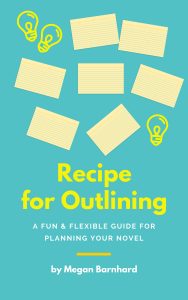The 3 Biggest Myths About Outlining Your Novel
 Do you avoid outlining, thinking it will stifle your creativity? Or do you do it but hate it?
Do you avoid outlining, thinking it will stifle your creativity? Or do you do it but hate it?
As a writing coach, I’ve seen outlining save so many authors — even those who consider themselves die-hard pantsers (writers who love to fly by the seats of their pants) or who are convinced they’ll never learn how to outline “properly.”
The key is they don’t realize they’re outlining.
You see, it’s not outlining that’s the problem; it’s what we believe about outlining. I’m going to debunk three of the biggest outlining myths so that you can plan your next novel with greater ease and success.
Myth #1 Outlining is Only for Linear Thinkers and People Who Love Spreadsheets
The truth: There’s an outlining style for every type of thinker.
A lot of creative people look at an outline for a novel—a spreadsheet, storyboard, plot hill, etc.—and think, “My brain is not that organized!”
But the way an outline looks and the way it’s built are very different, just like the book itself.
Outlining is a multi-step process that involves (1) capturing ideas, (2) ordering them based on story structure, and (3) writing them down in a recipe you can use as you’re drafting.
If you’ve always been put off by outlining, I’m guessing you were trying to do all three of these steps at the same time. That’s a tall order, and it can feel pretty overwhelming.
“Gathering ideas” looks different for each author. Your creative process might be linear, or it might be random, explosive, and beautifully chaotic. Maybe you dream about scenes or characters. Maybe you feel like a muse is working through you. Awesome! You don’t have to give that up in order to outline.
Use your unique process to gather ideas first. Once you have ideas to work with, you can put them in order using story structure templates to make sure you have all the key elements, like a believable inciting incident, dramatic rising action, and a thrilling climax.
Eventually, you can arrange your ideas into a recipe for writing. Maybe it will be a spreadsheet, or maybe it will be a bunch of sticky notes or a color-coded mind-map. You’ll end up with an organized outline you can follow, even though the process of making it might have been a bit of a whirlwind.
Myth #2 Your Outline Limits You
The truth: Your outline sets you free.
Many writers resist outlining because they love the exhilarating feeling of being inspired — of not knowing what they’re going to write next.
I bet you’ve had the experience of suddenly finding yourself writing a brilliant sentence, plot development, or line of dialogue that you hadn’t known was in you. It’s so fun, right?
Here’s the big secret: You can get more of those moments of inspiration if you outline. Your outline is a plan that directs your thinking. It’s a set of ideas to excite and energize your subconscious mind — or your muse, or Divine Inspiration — to give you amazing but unexpected ideas.
Plus, you’re allowed to change your mind! Just change your outline to match it. Cross stuff off. Switch out characters and places.
Let go of the myth that an outline locks you into one course of action. Instead, embrace the idea that your outline is your map, and if you decide you want to go somewhere different, you simply need a new map.
 Myth #3 You Must Outline the Whole Story Before You Start Writing
Myth #3 You Must Outline the Whole Story Before You Start Writing
The truth: Outlining is an ongoing process.
It’s pretty much impossible (and also really uninspiring) to do all the planning for your whole story before you start writing. Has that been holding you back? Did you feel like you had to pay your planning dues before you were even allowed to start writing your story?
Try outlining in stages: Plan, then draft, then plan more as you need to fill in the gaps about your characters and plot.
As you draft, your characters and world become more real, so when you pause to outline the next section, you’re more informed about what should happen.
On the flip side, if you’ve already outlined the next step of your story, you can set yourself free as you draft, allowing your creativity to take over completely because you already know you’re headed in the right direction.
Try It!
Start with one piece. Brainstorm ideas and start grouping them together into scenes or sections that seem to go together.
You don’t need to plan everything at once. And you don’t need to plan the way someone else would. Listen to your intuition and experiment with different ways of gathering ideas, ordering them, and then creating notes you can write from. I think you’ll be pleasantly surprised by how much time and energy outlining saves you. And that’s time and energy you can use to write.
—
About the Author: Megan Barnhard is an author and writing coach for inspired entrepreneurs and conscious creatives who want to make an impact with their words. She has been coaching writers for 12 years, helping them tame the writing process and tell their stories. This post is an excerpt from her latest book, Recipe for Outlining: A Fun & Flexible Guide for Planning Your Novel, available at meganbarnhard.com/book You can learn more about Megan’s intuitive approach to writing at meganbarnhard.com and follow her on Facebook @MeganBarnhardWriting for writing tips and live Q & A sessions.
Category: Contemporary Women Writers


























Two and three were both scary ideas to me when a friend suggested I outline my complicated mystery with the twenty-odd characters, two sub-plots and multiple twists. But once I realized, like my story, I was in control of what got on the paper, my writing life because far more pleasant. Now, I writed until I reach a point where I feel “stuck” and then I begin to outline for a while. I call it the sub-zero outline and it really helps me maintain momentum.
Daniel, it’s so great to hear how you overcame these fears and saw through the myths to create an outlining system that works for you.
Yes, moving back and forth between drafting and planning is the best. It gives you the chance to plan only as much as you need so that outlining doesn’t become burdensome.
What a fun book that sounds like — your mystery with many characters, sub-plots, and twists and turns! How is it going with your book?
Megan, you speak of a the kind of outlining that sounds a great deal like my process, especially the gathering stage. I do get my best ideas when I’m drying my hair and when I’m working in the garden…the subconscious is a powerful tool. Research (constant!) takes me in all kinds of directions I never planned. Sometimes I’ll ‘apply’ an outline to my work to ‘check’ it…example, the steps in the Hero’s Journey. For me, freedom is important. Organic outlining is what I do…never the same for any two books. But I must admit, I have an Excel spreadsheet to keep track of my series characters. Thanks for your take on unconventional outlining!
I totally relate to this — ideas striking when I’m doing things other than writing. Especially when I’m outside. A good excuse to take a walk or get into the garden. 😉
The process of “reverse outlining” can be so helpful! You get to match up your work to a structure (that you know works) without having to slow down for that structure as you write. I hear from so many of the writers I coach that the process is never the same twice. Each book is like a different child with unique needs and temperament. Part of the joy of creating, right? You never know how it will go.
Megan, Thanks for this post. It is the way I “outline.” The mulling, thinking in the shower, “Wait, I have to write that down” beginning part of a novel can be the most satisfying as various ideas lead to others. You might have taken away the burden part of outlining away for people who have avoided it.
So glad to hear this approach resonates with you, Mary. My goals is just what you said — to make outlining feel less burdensome and more empowering. Whether we’re writing or expressing ourselves in other ways, it is so satisfying to be able to wrangle our own minds so that we can create with greater ease.